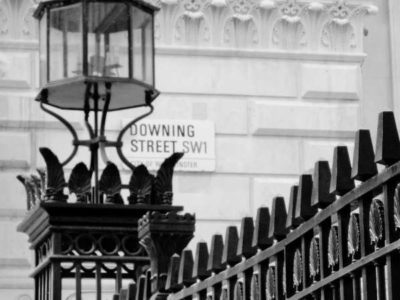Average house prices fell in November as the rate of annual growth slowed further to +4.7% (from +8.2%), with the typical UK property price now sitting at £285,579.
The monthly drop of -2.3% is the largest seen since October 2008 and the third consecutive fall.
While a market slowdown was expected given the known economic headwinds – and following such extensive house price inflation over the last few years (+19% since March 2020) – this month’s fall reflects the worst of the market volatility over recent months.
Some potential home moves have been paused as homebuyers feel increased pressure on affordability and industry data continues to suggest that many buyers and sellers are taking stock while the market continues to stabilise.
When thinking about the future for house prices, it is important to remember the context of the last few years, when we witnessed some of the biggest house price increases the market has ever seen.
Property prices are up more than £12,000 compared to this time last year, and well above pre-pandemic levels (+£46,403 vs March 2020).
The market may now be going through a process of normalisation.
While some important factors like the limited supply of properties for sale will remain, the trajectory of mortgage rates, the robustness of household finances in the face of the rising cost of living, and how the economy – and more specifically the labour market – performs will be key in determining house prices changes in 2023.
Nations and regions house prices
The slowing market is reflected across the UK, with most nations and regions seeing the rate of annual house price inflation fall last month.
The only exception remains the North East of England, which saw its rate of annual growth edge up slightly to +10.5% (from +10.4%).
It’s also now the only area of the UK with annual house price inflation in double figures, with an average property price of £173,587.
Wales (+7.9%, average price of £220,689) and the South West (+8.4%, average price of £307,750) have seen the sharpest slowdown of annual growth (from +11.5% and +10.7% respectively).
This is notable given both were key hotspots of house price inflation during the pandemic, suggesting that previous drivers of the market such as the race for space and heightened demand for rural living are now receding.
Scotland has also seen its pace of annual house price inflation continue to slow, now at +6.5% (from +7.4%) with a typical property now costing £203,132.
House prices in Northern Ireland are up +9.1% year-on-year, easing back from +9.7% last month, with an average property price of £185,097.
The pace of annual property price inflation also slowed in London, which continues to lag the other UK regions and nations.
House prices have risen +5.2% over the last 12 months, down from +6.6%.
The average property price in the capital remains well above the UK average at £549,160.
| Average house price | Monthly change | Quarterly change | Annual change |
|---|---|---|---|
| £293,835 | -0.1% | +1.3% | +9.9% |
Housing activity
HMRC monthly property transaction data shows UK home sales increased in October 2022.
UK seasonally adjusted (SA) residential transactions in October 2022 were 108,480 – up by 2.3% from September’s figure of 106,040 (down 3.1% on a non-SA basis).
Quarterly SA transactions (August-October 2022) were approximately 2.3% higher than the preceding three months (May 2022 – July 2022).
Year-on-year SA transactions were 38.0% higher than October 2021 (29.1% higher on a non-SA basis). (Source: HMRC)
Latest Bank of England figures show the number of mortgages approved to finance house purchases decreased in October 2022, by 10.6% to 58,977.
Year-on-year the October figure was 15.1% below October 2021. (Source: Bank of England, seasonally-adjusted figures)
The October 2022 RICS Residential Market Survey results point to a continued downward trend in market conditions.
New buyer enquiries fell for a sixth month in a row to a net balance of -55%, compared to -36% previously.
Agreed sales had a net balance of -45% (-29% previously) and new instructions returned a net balance of -17% (previously -13%). (Source: Royal Institution of Chartered Surveyors’ (RICS) monthly report)
Tom Bill, head of UK residential research at Knight Frank, comments:
“House prices in November moved sharply in the opposite direction to mortgage rates, which spiked following the mini-Budget.
The slightly confusing message for buyers and sellers is that mortgage rates should continue to edge down even as the Bank of England raises the base rate.
However, even as the financial pain becomes less acute in coming months, we expect it to become more widespread as more favourable mortgage offers made before the mini-Budget lapse.
This should take house prices back to where they were in the summer of 2021, erasing around half of the 20%+ gain they made during the pandemic.”
Jean Jameson, Chief Sales Officer at Foxtons, comments:
“December often brings opportunities for buyers to beat the new year rush.
Although the market has favoured sellers this year, we may be starting to see the pendulum swing and buyers regain purchasing power as competition falls and prices begin to level out.
The London market can’t be painted with too broad a brush, however, because some local markets fluctuate more than others.
Areas with needs-based markets tend to remain consistent as, for instance, families will look for housing in certain catchment areas no matter market conditions.
Central London has a high international audience and ultra-high net worth vendors with no urgent need to sell, so it’s also reliably stable.
In areas where house prices are decreasing, we may begin to see more activity with first-time buyers.”
Jeremy Leaf, north London estate agent and a former RICS residential chairman, comments:
“The housing market surveys are catching up with what’s been happening on the ground for the past few months.
Existing sales are holding up, providing no-one in the chain has to remortgage at a much higher rate.
As a result, prices are softening but continue to be supported by low stock and strong employment.
New business is hard to come by and only slowing returning now lending rates are starting to fall with buyers factoring in where they expect pricing to be next year.”
Tomer Aboody, director of property lender MT Finance, comments:
“With another fall in property prices in November, buyers and sellers are clearly demonstrating more caution due to higher mortgage rates and the ever-rising cost of living.
As with any fall in pricing, buyer sentiment and confidence is key.
But considering the macro-economic and seasonal factors affecting all consumers, along with the month- on-month increases seen over the past 18 months or so, the decline needs to be put into context as it is still minimal.
With fewer transactions taking place, it will be interesting to see whether the government will takes steps to encourage more activity in order to boost the wider economy, and whether mortgage lenders are willing and able to be more flexible on criteria.”
Mark Harris, chief executive of mortgage broker SPF Private Clients, comments:
“Annual house price growth continues to slow, as activity softens and the market gradually returns to something closer to what we were used to pre-pandemic.
Mortgage rates continue to float gently downwards but the psychological 5 per cent barrier has been broken for both two and five-year fixes.
With the next inflation data due next week and the MPC expected to announce another half-point increase in base rate, along with the usual festive slowdown, further softening is inevitable.”
Avinav Nigam, cofounder of real estate investment platform, IMMO, comments:
“This slowdown in house price growth was expected as this month’s data reflects decisions made earlier in the summer when rates began to rise.
Buying property is more expensive due to higher rates.
Perhaps more significantly, the stress tests applied by banks are also more stringent.
The result is that many who had hoped to purchase using mortgage finance will no longer be able to, with a disproportionate impact on younger and poorer households.
As it becomes harder and more expensive to buy, demand for rental properties continues to grow.
At the same time, rental listings are down significantly as landlords exit the market following an increase in the cost of complying with more regulations.
The opportunity for professional providers of safe, quality and affordable rental housing for the UK is increasingly clear.”
Alex Lyle, director of estate agency Antony Roberts, comments:
“Despite this continued slowdown in price growth on the back of increasingly challenging conditions, the market has proven to be remarkably resilient.
We are finding that sellers are being sensible and considering lower offers, sensing that sentiment has shifted a little over the past few months.
We expect plenty of soft marketing of property in the run-up to Christmas as agents and sellers test the market to find the correct level before launching new stock in the new year.
Good agents will also come into their own, while some of the lesser-experienced may fall away as the market is likely to be very different from the past 18 months.”
CEO of Alliance, the Real Estate Fund, Iain Crawford comments:
“The property market has taken some hits in the last few weeks but continues to hold up quite well given the significant, wider economic uncertainty that prevails.
The latest figures show that prices are down month on month but still up annually.
However, property has time and again proven to be a stable investment despite tricky economic times when viewed over the medium to long term.
As the market gradually returns to pre-pandemic norms and sentiment begins to stabilise, the smart ones will be those who saw the current period as an opportunity.
Indeed with Michael Gove throwing government house-building targets to the wind, we are likely to see major supply and demand imbalances for the foreseeable future and rising prices accordingly.”
Director of Benham and Reeves, Marc von Grundherr, comments:
“The UK property market seems to be sailing into some stormy seas as a market slowdown takes hold due to the challenges of economic uncertainty, rising inflation, higher interest rates, and a cost of living crisis gripping the nation this winter.
However the gradual reduction in house price growth should not be considered to be the arrival of the property market Grinch as falling mortgage rates are likely to buoy the market again by spring.”
Managing Director of Barrows and Forrester, James Forrester, comments:
“Although property values have dropped momentarily, the market continues to be higher on an annual basis despite the fact that we continue to face ongoing challenges but some of which are purely seasonal.
Many will also be quick to flag these drops as a sign that a property market crash is looming, but this amounts to little more than scaremongering.
It’s important that we view recent declines in context, as we are now merely starting to see a return back to pre-pandemic norms.
2023 will; not see a significant fall in house prices, mark my words, because stock remains short, new build homes are virtually non-existent in supply, and the long term mortgage rates are easing as quickly as they recently rose.”
Managing Director of House Buyer Bureau, Chris Hodgkinson, comments:
“The UK property market now looks to be entering a period of decline, with sustained price drops for the last three months – and this will be further fueled by sustained economic uncertainty and inflation that just refuses to be controlled.
Average the last few monthly data points and we’re looking at an annualised potential decline in home values of over 11%.
Something was always going to give after years of double digit increases and we are now starting to see the inevitable signs of a much less settled period ahead. Winter is indeed coming.”
CEO and co-founder of GetAgent.co.uk, Colby Short, comments:
“There’s no doubt that a lot of people will make mountains out of this price drop molehill but you can ask any estate agent you meet and they’ll tell you that the UK’s housing market is a million miles from danger.
Buyer appetite remains strong and, in the lead up to Christmas, agents have got plenty on their plates before the turkey is even served.
What we’re seeing here is an inevitable normalisation of what has been an historically frantic and expensive housing market.
It’s clear that we’re going to see further adjustments in 2023 but when panic is emblazoned across the front pages, take it with a pinch of salt.
We are a nation of aspirational homeowners. Safe as houses? You bet.”
Ben Woolman, Director at Woolbro Group, commented:
“House prices may be cooling but first-time buyers holding out for a substantial correction in the market shouldn’t hold their breath.
With Help to Buy ending and buyer borrowing power significantly weakened, the imbalance between the supply and demand is likely only set to get worse as construction of new homes stutters.
And coupled with average fixed-rate mortgage deals hovering at just under 6%, first-time buyers should temper their expectations of nabbing a bargain on a home any time soon.
Instead, the price gap between the average salary and average house prices means the prospect is now more out of reach than ever for many.
The Housing Secretary, therefore, must not cave to pressure from rebel MPs demanding mandatory housing targets are watered down.
This will only worsen Britain’s housing crisis by further empowering NIMBYs and those opposed to any and all development close to their own homes.
Secondly, reform of Britain’s planning system must be brought back to the table – it is undeniably the greatest obstacle of much-needed new homes and cannot be ignored.
And thirdly, a replacement to the Help to Buy scheme must be announced as soon as possible to give housebuilders the confidence they need to continue building new homes.
Cowing to NIMBY backbenchers by making councils even less accountable for missing targets is not only short-sighted but also damaging to the national interest – as well as the Tories’ reputation as ‘the party of ownership.”
Joshua Raymond, Director at online investment platform XTB.com comments:
“This is the biggest house price monthly fall since the last financial crisis and highlights the volatility in house prices in the aftermath of the mini-budget crisis.
It’s no surprise therefore to see such dramatic falls on a monthly basis and the fact the falls are felt fairly broadly across most UK regions highlights the fact the consequences of the mini-budget was felt across the entire sector.
Removal of mortgage offers, sharply higher borrowing costs and rising inflation are all key factors behind this fall in house prices.
It’s likely we will continue to see softer house prices but the question focuses on how hard a landing we might see for house prices.
A lack of supply alongside a strong labour market and the Bank of England telling the market to not expect too many more rate hikes could help soften the landing for falling house prices. Nevertheless, for the next year we are certainly likely to see more volatility in UK house prices.”





















Comments